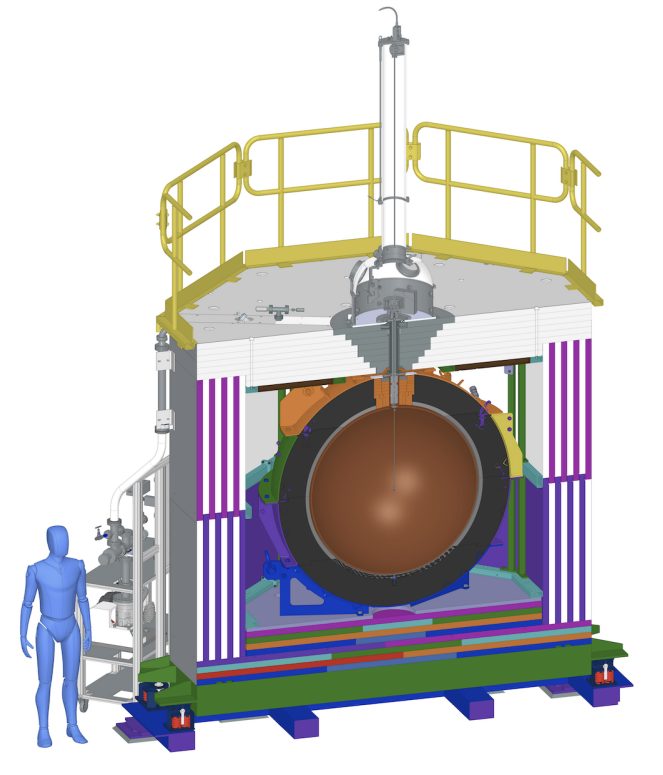NEWS-G releases background and experiment details
In a new article, the NEWS-G collaboration gives an in-depth analysis of radioactive background sources and detector design. Due to the depth and cleanliness of SNOLAB and the meticulous consideration given to the materials, construction, and assembly of the experiment, the background level is predicted to be 6 ± 2 events/kg/keV/day for sub-keV events.
3 minute read
NEWS-G (New Experiments with Spheres – Gas) is a 1.4m diameter spherical proportional counter dark matter detector poised to observe light dark matter candidates (<1GeV/c2). NEWS-G completed its installation at SNOLAB in December 2020, and began its commissioning phase August 10, 2021. Shortly after beginning operations, NEWS-G saw its “first light”, or rather, its first particle ionization.

Caption: Schematic view of the experiment. (Figure 3 from the ArXiv article)
The design of NEWS-G is based on the spherical proportional counter (SPC) being filled with a noble gas mixture with a small sensor at the centre. This small sensor, the ACHINOS sensor, is supported by a grounded copper rod and pushed to a high voltage to encourage charge collection. When weakly interacting particles scatter elections and ionize the gas atoms, the electrons drift towards the sensor and cause secondary ionizations which result in an avalanche effect of election-ion pairs. The secondary ions constitute most of the signal.
In a new article available on the ArXiv May 30, 2022, the NEWS-G collaboration released detailed information on the fabrication, background estimates, and overview of the experiment. A synopsis of considered background contributions can be found in Table 5 of the article. The main background source for NEWS-G is the cosmogenic activation in the copper sphere.
If it was possible for the copper sphere to remain underground for all stages of construction, assembly, and running, there would be little if any background signal from cosmogenic activation. However, the formation of the copper plates into hemispheres, welding of the copper hemispheres into the copper sphere, and transportation for the construction procedure as well as from Laboratoire Souterrain de Modane (LSM) in France, to SNOLAB in Ontario, Canada, required the copper sphere to be above ground and therefore exposed to cosmic rays.
Between when the copper was produced on December 8, 2017, and the arrival of the assembled copper sphere underground at SNOLAB on December 13, 2019, the copper was above ground and exposed to cosmic rays for a total of 146 days:
- Copper plates arrive at LSM 15 days after production, and then spend 18 days underground.
- Copper plates are sent to be formed into hemispheres and spend 38 days exposed to cosmic rays, and then spend 347 days underground.
- Copper hemispheres are above ground for 69 days for transport and operation to be welded into a sphere. The sphere then spent 181 days underground at LSM.
- The sphere spends 39 days above ground in transport to SNOLAB.
![A logarithmic line-graph with “Activity [Bq/kg]” as the vertical or dependent axis and “Time [day]” as the horizontal or independent axis. The presence of 54Mn, 56Co, 57Co, 58Co, and 60Co are shown with different coloured lines all showing increases during periods above ground and different rates of decline during periods underground. 56Co, 58Co, and 54Mn are currently below the threshold of the graph (below 0.00001 Bq/kg), 57Co is present but decreasing with time steadily, and 60Co is currently at the most prevalent, ~0.0003 Bq/kg, with a relatively slow rate of decline.](https://mcdonaldinstitute.ca/wp-content/uploads/2022/06/Screen-Shot-2022-06-13-at-12.00.39-PM.png)
Caption: Activity of the isotopes formed by cosmogenic activation during different steps of fabrication of the copper sphere. (Figure 8 from the ArXiv article)
A high level of care has been put into the mitigation strategies for all sources of background in NEWS-G. While cosmogenic activation of the copper sphere is the primary background source, the consideration of the intrinsic radioactivity of lead is interesting to note. The lead shielding around the copper sphere also contributes to the detector background, but the choice in the type of lead for NEWS-G has significantly reduced the impact. The lead shielding is constructed of two different shells, one of very low radioactivity (VLA) lead. The other is constructed of lead bricks excavated from a 2000 year old sunken Roman ship – referred to as Roman lead. In the span of 2000 years, 210Pb would have undergone approximately 100 half-lives, resulting in a material essentially free of radioactive 210Pb.
![A logarithmic scatter plot with “Rate [events/keV/kg/day]” on the vertical or dependent axis and “Energy [keV]” on the horizontal or independent axis. Different colours and shapes represent the background contribution in NEWS-G from the Roman Lead, Copper Sphere, VLA Lead, Laboratory (SNOLAB), Cosmogenic Activation, and the Total. Total is the highest data, starting at about 8 events/keV/kg/day at 0 keV, rising to about 20 events/keV/kg/day at 15 keV, and slowly tapering off back down to 8 events/keV/kg/day at 52 keV. The next highest backgrounds are Cosmogenic Activation, Copper Sphere, Roman Lead, VLA LEad, and Laboratory, respectively, with each data set having a bump at the 15 keV mark.](https://mcdonaldinstitute.ca/wp-content/uploads/2022/06/Screen-Shot-2022-06-13-at-11.34.04-AM.png)
Caption: Simulated energy spectrum of the NEWS-G experiment. (Figure 9 from the ArXiv article)
As stated by the NEWS-G collaboration, “The stringent selection of materials and care for background mitigation will ensure a very low background level. Study of the background shows that it is dominated by the copper sphere, with its cosmogenic activation and the presence of the 210Pb decay chain. At the time of the installation of the detector at SNOLAB, the background level is predicted to be 6 ± 2 events/kg/keV/day for sub-keV events.”
